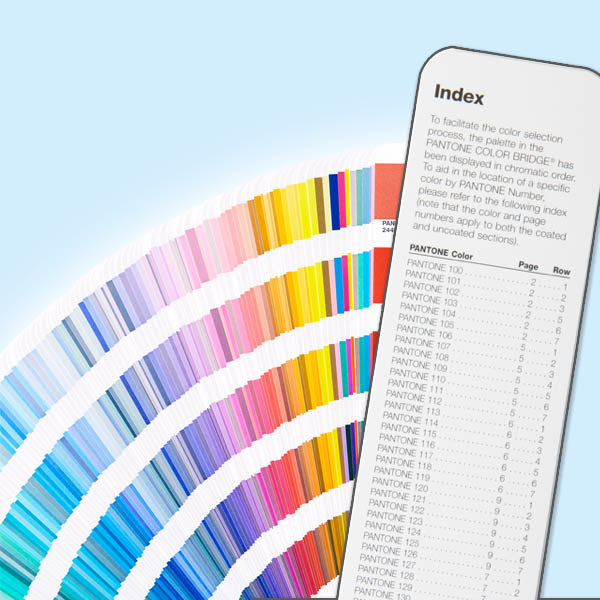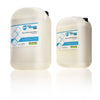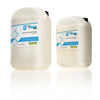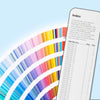How Pantone Colours Work

How Pantone Numbers Work
Each Pantone Matching System colour uses a unique coding scheme. This article will help you find which system and Pantone Colour number or name it is associated with:
Graphics and Multimedia

(Examples: PANTONE 185 C, PANTONE Cool Gray 1 U)
Pantone Formula Guides and Solid Chips contain 1,867 solid Pantone Matching System Colours for printing ink on paper. Most of these colours are referred to using a three- or four-digit number followed by a C or U. There are also a small number of named colours, such as the 18 base colours like PANTONE Reflex Blue C or PANTONE Orange 021 U.
The letter suffix refers to the paper stock on which it is printed: a "C" for coated or gloss paper or a "U" for uncoated paper.
Pantone Speciality Solid Colours
Pantone Metallics(Examples: PANTONE 877 C, PANTONE 8244 C)
Pantone Metallics Colours are referenced using either a three- or four-digit number that begins with “8”, followed by a “C” to indicate a coated paper stock. There is no uncoated version of Pantone Metallics Colours.
Pantone Premium Metallics(Example: PANTONE 10286 C)
Pantone Premium Metallics Colours are referenced using a five-digit number that begins with “10”, followed by a “C” to indicate coated paper stock. There is no uncoated version of Pantone Premium Metallics Colours.
Pantone Pastels & Neons(Examples: PANTONE 915 U, PANTONE Yellow 0131 C)
Pantone Pastels & Neons Colours are referenced using either a three- or four-digit number beginning with “9”. There are two exceptions: The neon base colours, which are three-digit numbers beginning with “8”, and the pastel base colours, which are named with a descriptive colour name, followed by a four-digit number that begins with “0”. Each colour has a suffix that indicates the type of paper stock on which it is printed: a "C" for coated or gloss paper or a "U" for uncoated paper.
CMYK & Four–Colour Process
Pantone CMYK & 4–Colour Process Guides Coated or Uncoated(Examples: PANTONE P 11-4 C, PANTONE P 69-15 U).
These guides offer an independent collection of nearly 3,000 CMYK colours that bear no relationship to the Pantone Matching System.
Pantone Process Colour numbers start with the letter P followed by a one- to three-digit number, a dash, and a one- to two-digit number. The "C" suffix indicates coated stock and the "U" uncoated.
Process Simulations of Solid Pantone Colours
Pantone Colour Bridge Coated or Uncoated(Example: PANTONE 185 CP, PANTONE 425 UP)
This guide provides side-by-side printed comparisons of solid Pantone Matching System Colours and their closest four-colour process equivalent. The process simulation is identified by using the solid colour's name or number, followed by "CP" for coated or "UP" for uncoated.
Pantone Extended Gamut Coated Guide(Examples: PANTONE 7662 XGC, PANTONE 347 XGC)
The Pantone Extended Gamut Coated guide contains 1,729 seven-colour simulations of the solid Pantone Matching System Colours printed on coated stock. Most of these colours are referred to using a three- or four-digit number followed by an XGC. There are also a small number of named colours, such as the seven base colours like PANTONE Process Magenta C or PANTONE XG Orange C.
The letter suffix refers to the type of process: “XG” for Extended Gamut and a "C" for the coated or gloss paper on which it is printed.
Pantone Fashion, Home + Interiors

(Examples PANTONE 14–4510 TPX or Aquatic, PANTONE 15–1247 TCX or Tangerine)
Colour reference numbers in this system contain two digits followed by a dash and four digits with either a TPX or TC suffix. TPX indicates that that the reference was printed on paper, the TC indicates that it’s a dyed cotton reference. Each colour also has an alpha name reference as a secondary identifier. Now in eco-friendly formulations indicated by TPG colour suffix. This new edition of the Colour Guide presents the existing 2,310 Fashion, Home + Interiors Colours created from new, more Earth-friendly formulations and an accompanying new Pantone Colour Number suffix, TPG (Textile Paper – “Green”).
Pantone Plastics

(Examples PANTONE Q270–2–4, PANTONE T925–5–5)
Pantone Plastics Selector colour references are denoted by a Q or a T followed by a three–digit number, a dash and two single digits separated by a dash. The Q and T signify opaque and transparent colours, respectively.
Pantone Plastic Standard Chips (large plastic chips)(Examples PANTONE PQ-185C, PQ-19-4007TCX)
Pantone Plastic Standard Chips are matched to the colours in the Pantone Matching System or Pantone Fashion, Home + Interiors Colour System. The chips have two levels of thickness are made using Polypropylene resin.
Pantone Plastic Standard Chips colour references matched to the Pantone Matching System are denoted by a PQ followed by a dash and the three- or four-digit colour number (corresponding to the Pantone Matching System) plus a “C”. PANTONE Plastic Standard Chips colour references matched to the Pantone Fashion, Home + Interiors Colour System are denoted by a PQ followed by a dash, two digits, a second dash, and the final four digits of the matched Fashion, Home + Interiors plus the TCX suffix.- Clive Harper






